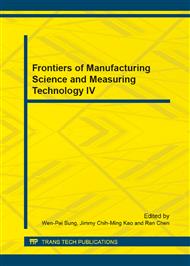[1]
Stone, J. A., Amer, M., Faust, B., & Zimmerman, J. (2003, November). Angle metrology using AAMACS and two small-angle measurement systems. In Optical Science and Technology, SPIE's 48th Annual Meeting (pp.146-155.
DOI: 10.1117/12.506481
Google Scholar
[2]
Stone, J. A., Amer, M., Faust, B., & Zimmerman, J. (2004). Uncertainties in small-angle measurement systems used to calibrate angle artifacts. JOURNAL OF RESEARCH-NATIONAL INSTITUTE OF STANDARDS AND TECHNOLOGY, 109, 319-334.
DOI: 10.6028/jres.109.024
Google Scholar
[3]
W. T. Estler, Y. H. Queen, and D. Gilsinn, Advanced Angle Metrology at the National Institute of Standards and Technology, Proc. 6th Annual ASPE (1991) pp.21-24.
Google Scholar
[4]
R. Probst and R. Wittekoph, Angle calibration on precision polygons, Final Report of EUROMET Project #371, report PTB-F-43 (Physikalisch-Technische Bundesanstalt, Braunschweig, Germany) (2001).
Google Scholar
[5]
ISO/TS 12781-1: 2003. Geometrical product specifications (GPS) – Flatness – Part 1: Vocabulary and parameters of flatness. International Organization for Standardization. Geneva.
DOI: 10.3403/30158860
Google Scholar
[6]
Cui, C., Li, B., Huang, F., & Zhang, R. (2007). Genetic algorithm-based form error evaluation. Measurement science and technology, 18(7), 1818.
DOI: 10.1088/0957-0233/18/7/004
Google Scholar
[7]
Deng, G., Wang, G., & Duan, J. (2003). A new algorithm for evaluating form error: the valid characteristic point method with the rapidly contracted constraint zone. Journal of materials processing technology, 139(1), 247-252.
DOI: 10.1016/s0924-0136(03)00229-2
Google Scholar
[8]
Wen, X. L., Zhu, X. C., Zhao, Y. B., Wang, D. X., & Wang, F. L. (2012). Flatness error evaluation and verification based on new generation geometrical product specification (GPS). Precision Engineering, 36(1), 70-76.
DOI: 10.1016/j.precisioneng.2011.07.006
Google Scholar
[9]
Cui, C., Li, T., Blunt, L. A., Jiang, X., Huang, H., Ye, R., & Fan, W. (2013). The Assessment of Straightness and Flatness Errors Using Particle Swarm Optimization. Procedia CIRP, 10, 271-275.
DOI: 10.1016/j.procir.2013.08.041
Google Scholar
[10]
Zhang, L., Yang, X. M., Liu, H., & Guan, P. (2011). Evaluation of the Axial End Flatness Error Based on Genetic Algorithm. Advanced Materials Research, 230, 329-333.
DOI: 10.4028/www.scientific.net/amr.230-232.329
Google Scholar
[11]
Lay, D. C. Linear Algebra and its Applications. (2000).
Google Scholar
[12]
Haupt, R. L., & Haupt, S. E. (2004). Practical genetic algorithms. John Wiley & Sons, Hoboken.
Google Scholar
[13]
Shopova, E. G., & Vaklieva-Bancheva, N. G. (2006). BASIC—A genetic algorithm for engineering problems solution. Computers & chemical engineering, 30(8), 1293-1309.
DOI: 10.1016/j.compchemeng.2006.03.003
Google Scholar
[14]
Coley, D. A. (1999). An introduction to genetic algorithms for scientists and engineers. World Scientific, Singapore.
Google Scholar
[15]
Michalewicz, Z. (1996). Genetic algorithms + data structures= evolution programs. Springer-Verlag, New York.
Google Scholar


